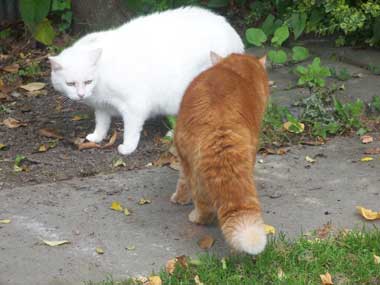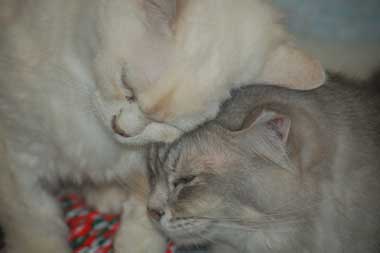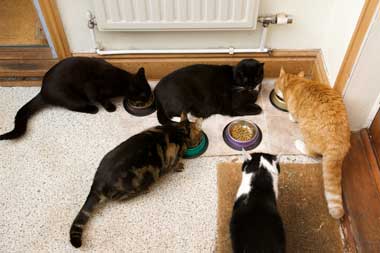5. Solitary: domestic cat
Domestic cats need to have the choice to be solitary
Like their ancestors, domestic cats still have an inherent desire to maintain an independent territory and are generally happy to live without other cats for company.
Due to their popularity as pets, many cats live in close proximity, particularly in residential areas, all of which are trying to maintain a territory. Because of this there can be evidence of conflict – for example cat-bite abscesses, commonly seen on the head and on the bottom area.
Cats would much prefer to actively avoid conflict with others by running away, getting up high or hiding
Many cats living together under the same roof only tolerate the presence of others to gain access to valued resources (eg food, water, toileting area and outdoor access). This can result in anxiety and chronic stress, which is not always obvious – especially as cats often spend time together to access the resource.
Thinking of adding to the family?
The introduction of a new cat to existing cats can cause stress for both parties, and if an appropriate, gradual integration programme is not followed, may lead to a behaviour ‘problem’ such as spraying or inappropriate toileting. Introducing unfamiliar cats should be done very slowly in the hope that they will ultimately perceive each other to be in the same social group or at least peacefully cohabit due to the provision of ample resources in separated locations to avoid conflict and competition.
Each new relationship is dependent on the individuals and the management of their early encounters. Unfortunately there is no guarantee that even with careful management the introduction of unfamiliar cats will work out.
Having more than one cat at home
Multi-cat households can be harmonious, if cats are able to choose to be independent which reduces feelings of competition and keeps anxiety levels low. This can be assisted by careful introductions and giving each cat the ability to access separate and sufficient resources without having to interact with any other cat, or other potentially stressful situation (children, dogs, noisy household appliances).
There are some cats that like each other. Cats which sleep touching and spend time grooming or rubbing against each other are likely to be in the same ‘social group’ or ‘friends’ and should still be provided with separate resources than cats in a different social group, even if they live in the same household.
The aim of providing separate resources is to allow cats that are not in the same social group to live independently – a golden rule is one resource per cat plus one extra.

Cats show the 'face-off' behaviour as they don't really have appeasement signals to diffuse the situation in the same way that social species like dogs do.
Original image URL - http://www.flickr.com/photos/nzlawyer/2251740603/ Image author - nzlawyer (no real name given), licence - CC BY-NC-ND 2.0Cats that are in the same social group will show behaviours such as allogrooming, allorubbing and will sleep touching each other. Allo is Greek for ‘other’ or ‘different’ so allogrooming means ‘grooming another’ such as another cat, and allorubbing means ‘rubbing another’.

Cats in the same social group, showing allorubbing.
Original image URL - http://www.flickr.com/photos/kerrybuckley/2452975762/in/photostream/ Image author - Kerry Buckley, licence - CC BY-NC-SA 2.0

